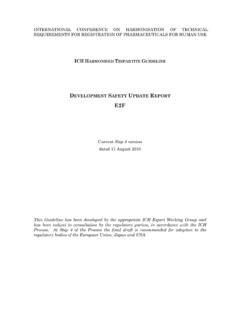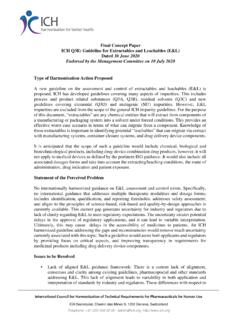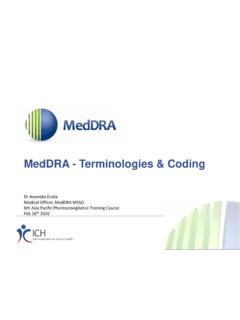Transcription of Q12 - ICH
1 INTERNATIONAL COUNCIL FOR HARMONISATION OF TECHNICAL REQUIREMENTS FOR PHARMACEUTICALS FOR HUMAN USE ICH HARMONISED GUIDELINE TECHNICAL AND REGULATORY CONSIDERATIONS FOR PHARMACEUTICAL PRODUCT LIFECYCLE MANAGEMENT Q12 Draft version Endorsed on 16 November 2017 Currently under public consultation At Step 2 of the ICH Process, a consensus draft text or guideline, agreed by the appropriate ICH Expert Working Group, is transmitted by the ICH Assembly to the regulatory authorities of the ICH regions for internal and external consultation, according to national or regional procedures. Q12 Document History Code History Date Q12 Endorsement by the Members of the ICH Assembly under Step 2 and release for public consultation (document dated 31 October 2017). 16 November 2017 Legal notice: This document is protected by copyright and may, with the exception of the ICH logo, be used, reproduced, incorporated into other works, adapted, modified, translated or distributed under a public license provided that ICH's copyright in the document is acknowledged at all times.
2 In case of any adaption, modification or translation of the document, reasonable steps must be taken to clearly label, demarcate or otherwise identify that changes were made to or based on the original document. Any impression that the adaption, modification or translation of the original document is endorsed or sponsored by the ICH must be avoided. The document is provided "as is" without warranty of any kind. In no event shall the ICH or the authors of the original document be liable for any claim, damages or other liability arising from the use of the document. The above-mentioned permissions do not apply to content supplied by third parties. Therefore, for documents where the copyright vests in a third party, permission for reproduction must be obtained from this copyright holder.
3 I ICH HARMONISED GUIDELINE TECHNICAL AND REGULATORY CONSIDERATIONS FOR PHARMACEUTICAL PRODUCT LIFECYCLE MANAGEMENT Q12 ICH Consensus Guideline TABLE OF CONTENTS 1. INTRODUCTION .. 1 Objectives .. 1 Scope .. 1 ICH Q12 Regulatory Tools and Enablers .. 1 2. CATEGORISATION OF POST-APPROVAL CMC CHANGES .. 3 3. ESTABLISHED CONDITIONS (ECS) .. 4 Introduction .. 4 Definition of ECs and Their Role in the Regulatory 4 ECs Definition .. 4 ECs in a Regulatory 5 Identification of ECs .. 5 Identification of ECs for the Manufacturing Processes .. 5 Identification of ECs for Analytical Procedures .. 8 Revision of ECs .. 8 Roles and Responsibilities .. 9 4. POST-APPROVAL CHANGE MANAGEMENT PROTOCOL (PACMP) .. 9 Definition of a PACMP .. 9 Application of a PACMP.
4 10 Elements of a PACMP .. 10 Modification to an Approved PACMP .. 11 Types of PACMPs .. 11 5. PRODUCT LIFECYCLE MANAGEMENT (PLCM) .. 12 PLCM Document: Scope .. 12 Submitting the PLCM Document .. 13 Maintenance of the PLCM Document .. 13 Format and Location of PLCM Document .. 13 6. PHARMACEUTICAL QUALITY SYSTEM (PQS) AND CHANGE MANAGEMENT .. 13 General 13 Management of Manufacturing Changes in the Supply Chain .. 14 7. RELATIONSHIP BETWEEN REGULATORY ASSESSMENT AND INSPECTION .. 14 8. POST-APPROVAL CHANGES FOR MARKETED PRODUCTS .. 14 ii Structured Approach to Analytical Procedure Changes .. 15 Principles .. 15 Structured Approach .. 16 Data Requirements to Support CMC Changes .. 18 Stability Data Approaches to Support the Evaluation of CMC Change.
5 18 9. GLOSSARY .. 19 10. REFERENCES .. 20 APPENDIX 1: CTD SECTIONS THAT CONTAIN ECS .. 21 APPENDIX 2: PRINCIPLES OF CHANGE MANAGEMENT .. 25 ICH Q12 Guideline 1 1. INTRODUCTION Objectives The concepts outlined in prior ICH Quality Guidelines (ICH Q8, Q9, Q10 and Q11) provide opportunities for science and risk-based approaches for drug development and risk-based regulatory decisions. These guidelines are valuable in the assessment of Chemistry, Manufacturing and Controls (CMC) changes across the product lifecycle. ICH Q8 and Q11 guidelines focus mostly on early stage aspects of the product lifecycle ( , product development, registration and launch). Experience with implementation of recent ICH guidelines has revealed technical and regulatory gaps that limit the full realisation of more flexible regulatory approaches to post-approval CMC changes as described in ICH Q8 (R2) and Q10 Annex I.
6 This guideline addresses the commercial phase of the product lifecycle (as described in ICH Q10). A harmonised approach regarding technical and regulatory considerations for lifecycle management will benefit patients, industry , and regulatory authorities by promoting innovation and continual improvement in the biopharmaceutical sector, strengthening quality assurance and improving supply of medicinal products. This guideline provides a framework to facilitate the management of post-approval CMC changes in a more predictable and efficient manner. It is also intended to demonstrate how increased product and process knowledge can contribute to a reduction in the number of regulatory submissions.
7 Effective implementation of the tools and enablers described in this guideline should enhance industry s ability to manage many CMC changes effectively under the firm s Pharmaceutical Quality System (PQS) with less need for extensive regulatory oversight prior to implementation. The extent of operational and regulatory flexibility is subject to product and process understanding (ICH Q8 and Q11), application of risk management principles (ICH Q9), and an effective pharmaceutical quality system (ICH Q10). In certain ICH regions, the current ICH Q12 guideline is not fully compatible with the established legal framework with regard to the use of explicit Established Conditions ('EC') referred to in Chapter 3 and with the Product Lifecycle Management ('PLCM') referred to in Chapter 5 as outlined in this guideline.
8 These concepts will, however, be considered when the legal frameworks will be reviewed and, in the interim, to the extent possible under the existing regulation in these ICH regions. Scope This guideline applies to pharmaceutical drug substances ( , active pharmaceutical ingredients) and pharmaceutical drug products, including marketed chemical, and biotechnological/biological products. The guideline also applies to drug-device combination products that meet the definition of a pharmaceutical or biotechnological/biological product. Changes needed to comply with revisions to Pharmacopoeial monographs are not in scope of this guideline. ICH Q12 Regulatory Tools and Enablers Use of the following harmonised regulatory tools and enablers with associated guiding principles, as described in this guideline, will enhance the management of post-approval changes, and transparency between industry and regulatory authorities, leading to innovation and continual improvement.
9 ICH Q12 Guideline 2 Categorisation of Post-Approval CMC Changes (Chapter 2) Categorisation of Post-Approval CMC Changes is a framework that encompasses a risk-based categorisation for the type of communication expected of the Marketing Authorisation Holder (MAH) with the regulatory authority regarding CMC changes. Established Conditions (ECs) (Chapter 3) The concept of ECs provides a clear understanding between the MAH and regulatory authorities regarding the necessary elements to assure product quality and identify the elements that require a regulatory submission, if changed. This guideline describes how ECs are identified as well as what information can be designated as supportive information that would not require a regulatory submission, if changed.
10 In addition, guidance is included for managing revisions of the ECs over a product s lifecycle. Post-Approval Change Management Protocol (PACMP) (Chapter 4) The PACMP is a regulatory tool that provides predictability regarding the information required to support a CMC change and the type of regulatory submission based on prior agreement between the MAH and regulatory authority. Such a mechanism enables planning and implementation of future changes to ECs in an efficient and predictable manner. Product Lifecycle Management (PLCM) (Chapter 5) The PLCM document serves as a central repository for the ECs and the associated reporting category for changes made to ECs. The document also captures how a product will be managed during the commercial phase of the lifecycle including relevant post-approval CMC commitments and PACMPs.
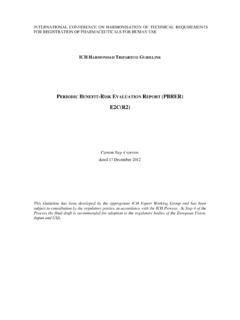
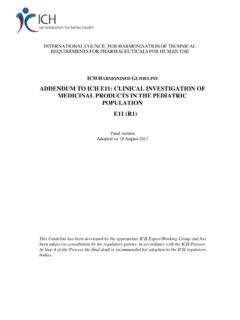
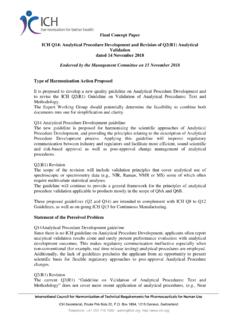
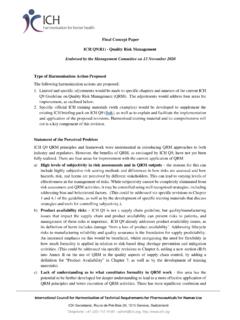
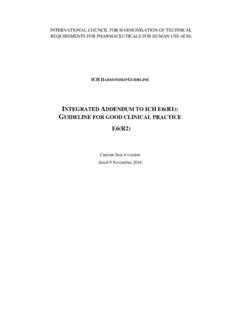
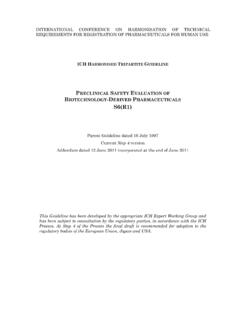
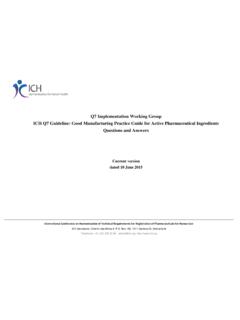
![[ICH E2F] [EXAMPLE DSUR – PHASE III INVESTIGATIONAL …](/cache/preview/e/7/a/2/e/6/3/0/thumb-e7a2e63043c4463724e748eb98faa3a7.jpg)
